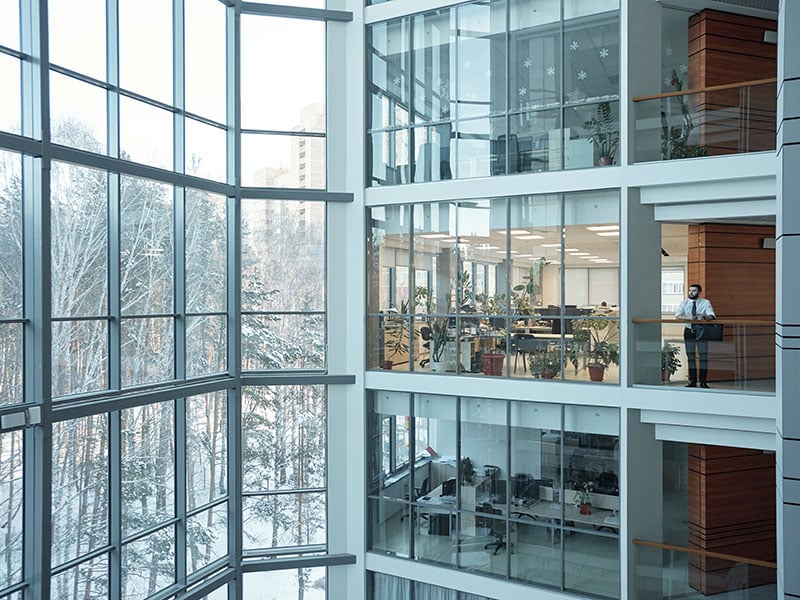As a result of the COVID-19 pandemic, 88% of organizations across the globe made it mandatory or encouraged employees to work from home. As businesses begin to reopen and some sense of normalcy returns, millions of employees will return to their offices.
After several months of remote work for most employees, it’s imperative for employers to:
- Offer workplaces that meet health and safety expectations.
- Additionally, create an office environment that employees want to return to.
It’s clear the office is not “dead,” but that the office as we’ve always known it will certainly look different as we head back to work. Updated office health and safety, and design and infrastructure guidelines are a must before employers ask or require employees to return to work.
How employees feel about returning to the office
As eager as you may (or may not) personally be to return to the office, it’s crucial to gauge how ready your team members are to return to the office as well. With so many different perspectives and competing statistics out there about how employees feel, how can you know how your team is really thinking about leaving their home offices?
Do employees want to return to the office, or do they prefer working from home long term?
Employees generally want to return to the office, but only after certain changes are made. “According to a Gensler survey, only 12% of people want to continue to work from home full-time after the pandemic subsides.”
Employees want continued work-from-home flexibility. Meaning once the office reopens, workers want the opportunity to work from home a couple of days a week.
What do employees miss about the office?
The Gensler survey reports that the number one reason people want to return to work is that they miss the personal connection and collaboration opportunities.
“Nearly 55% of those surveyed said it’s harder to collaborate when everyone is telecommuting, and 51% said it’s more difficult to keep up with what their colleagues are working on.”
In other words, employees recognize the loss of spontaneous interactions that create meaning for themselves and value for their companies. The survey suggests that our changing expectations of how we work are also changing the role of the physical workplace.
These factors require employers to strategically redesign and prepare their office for re-entry.
4 must-have offerings of the modern workplace
Throughout most of 2020, employees have become used to an entirely new routine. Even if most of your employees want to return to the office, you need to make it worth the commute and the “trouble” of going into the office.
Here are some of the must-have offerings you should incorporate into your office.
1. Physical Safety
Safety takes on a whole new meaning in the modern office and the office of the future. Health and safety will be top of mind for employees. Here’s are some tips for a safer, healthier workplace:
- Conduct frequent risk assessments and report findings to your team.
- Establish a clear, potentially more lenient, policy for sick days.
- Ensure proper office ventilation and air conditioning. The World Health Organization (WHO) recommends an increased ventilation rate through natural aeration or artificial ventilation. It’s also crucial to replace air filters or clean them regularly.
- Consider temperature screenings. The Equal Employment Opportunity Commission (EEOC) granted permission to employers to conduct temperature screenings upon employees’ arrival to work. These screenings can prevent possible positive cases from walking through your office doors.
- Think about hotelling. Many employers are anticipating downsizing along with the use of shared office spaces for employees who primarily work from home but need a touchdown space when in the office. In order for employees to feel comfortable using these types of spaces, comprehensive cleaning protocols and reporting will be required.
2. New Policies
Embrace the positives of working from home by allowing it in certain situations, on specific days, or leave it flexible to each employee.
Consider the following when developing these policies:
- Returning to the office will be a large adjustment, so be sure to make these policies easy to understand and ensure every employee is familiar with the new policies.
- If possible, consider flexible work-from-home policies by allowing your employees to opt-in to remote work or to work in the office. Giving employees the freedom to choose their work situation will help them decide whether they’re ready to return to the office without fear of repercussions.
- In many cases, coordination within departments or project teams will be necessary.
3. Cosmetic Updates
Again, your office now needs to be worth the commute. Consider investing in cosmetic upgrades to your space to attract and retain employees. As you work to implement physical distancing among desks and chairs in your office, what other design concepts can you adapt to make the space feel more inviting?
- Natural lighting: According to Occupational Health and Safety, natural light in the workplace can positively impact employees such as their moods, Vitamin D level, eye health, productivity, and even sleep patterns.
- Modern fixtures and colors: In the future of work, employees will need an engaging and pleasing work environment to come to.
- Biophilic design: Biophilic design is a concept used throughout the commercial real estate industry in which nature and greenery are incorporated throughout the workplace. According to the Global Impact of Biophilic Design in the Workplace report, employees who work in environments with biophilic design elements are 15 percent more productive.
4. Productivity Improvements
There is no one clear answer in terms of how productivity has changed because of COVID-19. Certain reports show people are more productive working from home, while others observe a decrease in productivity. It really comes down to a matter of personal preference and how individuals and teams work best. The type of work, job classifications, team communication and personality types can also be factors.
Here are three ideas for creating the most productive work environment for your team:
- Healing offices: The workplace must now act as a space that functions as more than just a building to work in. Healing offices are offices that engage employees by offering healthy and re-energizing spaces. By offering a workplace that encourages healthy habits, you can prevent your employees from feeling burnt out. This concept, according to design firm D Dock, can be translated in various ways such as a meditation room, contemplation niches, and even the opportunity to take power naps.
- Ability to customize their own work stations: Your team is used to working in the comfort of their own home. Allowing slight customizations to the office space can go a long way in making your team feel right at home.
- Sustainability: Incorporating sustainable amenities and design concepts can lead to higher productivity. D Dock goes on to explain that proper sustainable elements can lead to a 10% increase in productivity with a general boost in energy and stress reduction.
Ready to prepare your office for re-entry?
Start preparing your office for the inevitable return with a proper plan. Our Allegro experts are standing by ready to discuss ways to manage your property during this unprecedented time and position you for a successful future. Book a free 30-minute consultation today.







